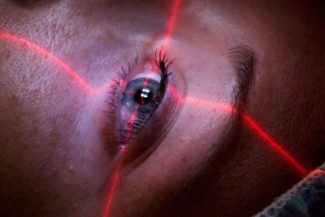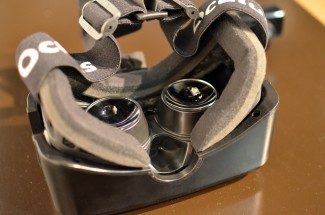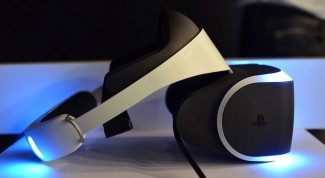 The buzz surrounding virtual reality continues to grow and now at least one enthusiast is so convinced by the technology that he has opted for laser eye surgery, after 30 years of wearing glasses, to enhance the Oculus Rift experience.
The buzz surrounding virtual reality continues to grow and now at least one enthusiast is so convinced by the technology that he has opted for laser eye surgery, after 30 years of wearing glasses, to enhance the Oculus Rift experience.
Reddit user ceno666, who prefers to keep his real name anonymous, is farsighted with astigmatism, an eye condition where the optics of the eye cannot sharply focus an image onto the retina. Astigmatism affects some 28% of children, aged 5-17, according to a study published in the journal JAMA Ophthalmology.
Ceno tells me he’s been wearing glasses for 30 years. “…in fact [I] very well and kind of accept them as part of my body as most people with eye correction do,” he said. “Never thought much about the laser surgery until the Rift, that’s for sure.”
“I am maybe a little obsessive to try to get the best experience when it comes to any kind of media I consume, especially in the case of gaming… It was clear since FPV (first person view flight) headgear and now the Oculus Rift, it’s bad luck if you need vision correction,” Ceno says. “My compromise with any kind of HMDs was mostly: use it with the glasses, with all the uncomfortable effects (scratched lenses, FOV and adjustment problems, uncomfortable pressure marks… you name it) or without glasses (lately I always use the Rift without).”
Ceno tells me he has an appointment for the $2200 laser surgery on the 13th of this month. The goal of the surgery is to eliminate the need for glasses, so that using the Oculus Rift VR headset is more comfortable and so the image will be sharper.

The Oculus Rift DK2 can accommodate some eye glasses, but the result is a lower field of view as the glasses increase the distance from the eyes to the lenses. It can also be quite uncomfortable.
The Oculus Rift DK1 came with three sets of lenses to help users with nearsightedness. The A lenses are for normal vision while the B and C lenses are for slightly nearsighted and very nearsighted users, respectively. The DK2 comes with two sets of lenses, A for normal vision, and B for slightly nearsighted users. For both headsets, Oculus recommends using the A lenses for users wearing glasses or contacts, or using the other sets without corrective eyewear.
“For me it is clear, my eyeglasses are like an obstacle for optimal VR experience,” Ceno wrote on a thread in the Oculus Rift section of Reddit. “The Rift is for me the main factor for this decision… with the DK1 and now the DK2 in all its glory… I just dont want to wear glasses underneath, for me its uncomfortable… and they are kind of getting in the way of the experience. I dont want to say the Rift is the only reason, sure the daily routine would benefit as well.” Ceno’s thread on Reddit is filled with others who have considered laser eye surgery for VR, along with many who suggest using contacts instead.
“I just don’t like them and for my eyes only hard lenses are an option… I hate fiddling with my eyes every day as well,” Ceno said about using contacts instead of resorting to laser surgery.
Not everyone will be able to get laser surgery to avoid using glasses with the Rift. Oculus VR is well aware of the need for a headset that works comfortably with glasses; they noted long ago in their Kickstarter FAQ that “…we have a lot of great ideas for supporting glasses in the consumer version [of the Rift] (especially since a huge portion of the Oculus team wears glasses everyday!).”

Sony’s Project Morpheus headset uses a head mounted design that is closer to flip-down welding glasses than the ski goggle design of the DK1 and DK2. At this point, Morpheus is more comfortable to use with glasses as the display hangs down in front of your eyes instead of pressing against your face. It still suffers reduced FOV when using glasses because of an increase in the eye to lens distance.
Ceno, 34, is a VR enthusiast from central Europe. He owned the first version of the Oculus Rift, the DK1, and now has the recently released DK2. He says he’s used other head mounted displays for FPV (first person view) flight, attaching a camera to an R/C flying vehicle and seeing through its perspective.
See Also: How Virtual Reality Can Teach You to Fly
I asked Ceno what his favorite experiences were with the Oculus Rift.
“I try as many tech demos as possible, with DK1 the most impressive game for me was Lunar Lander or Proton Pulse and ‘experiences’ like Lunadroid 237 or Blocked In,” he said. “Lately I mostly play the Elite: Dangerous beta, the devs clearly understand how to put you into a virtual starship, I love this game and how they implemented the Rift so far… and this is just the beginning.”
See Also: We Play Elite: Dangerous in the DK2 – In-Depth Hands-on Video
Best of luck to Ceno with his surgery. We’ll be sure to catch up after the procedure to see how things go!







